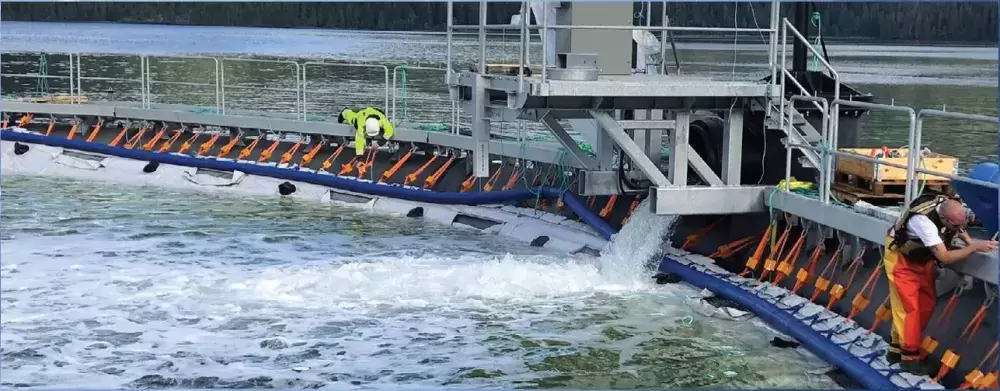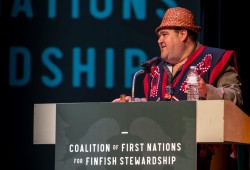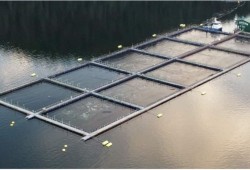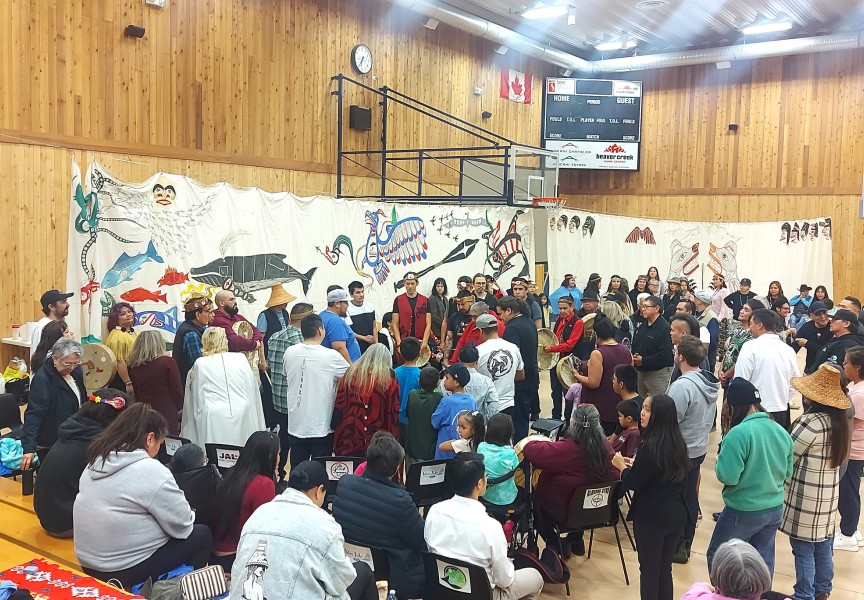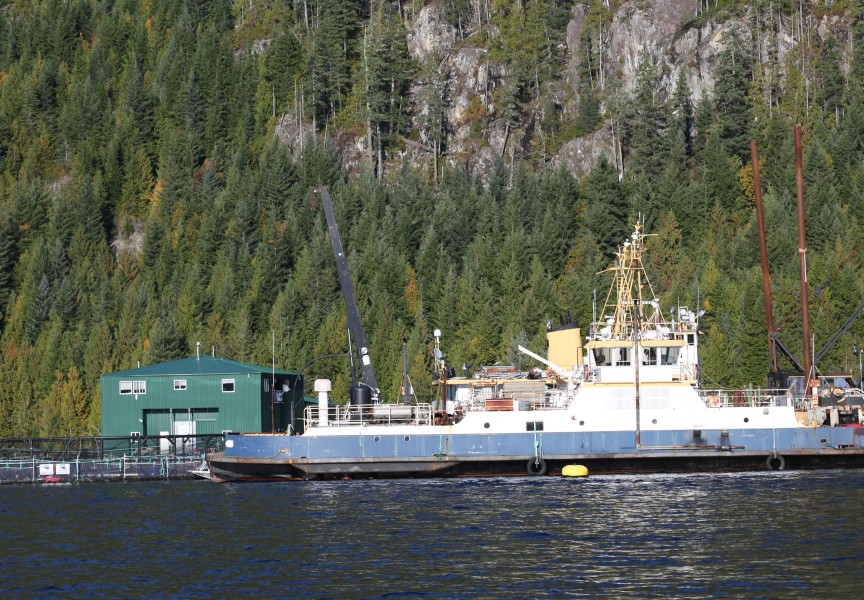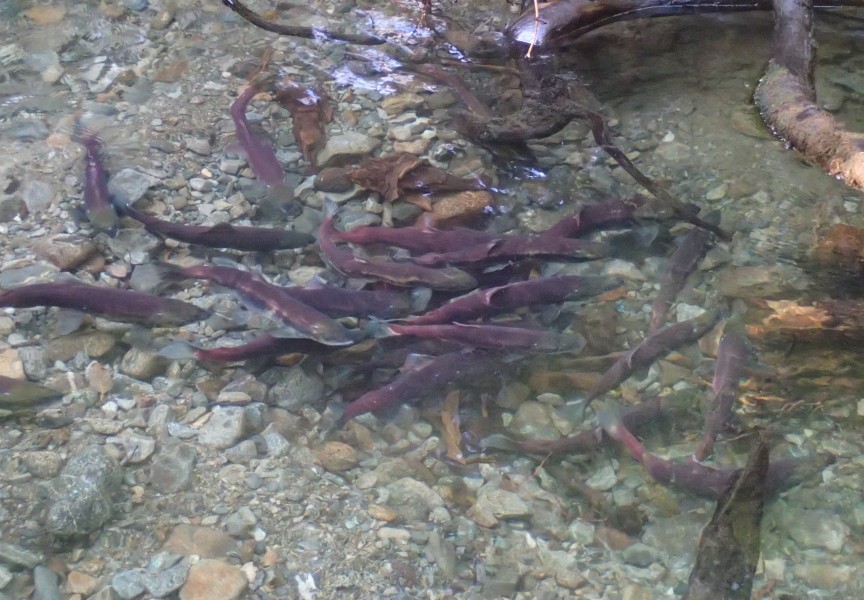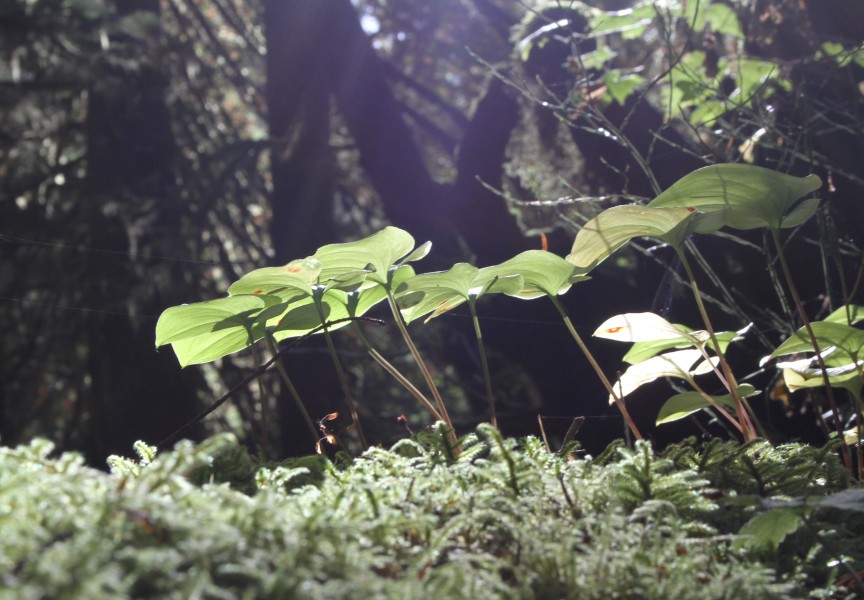After a disappointing first trial, the second batch of fish being raised in a semi-closed system in Ahousaht territory is “exceeding expectations”, raising hope that the technology will add another stage to salmon farming that removes contact between farmed and wild stocks.
Cermaq has overseen the Atlantic salmon at its Millar Channel site for more than three months since the trial began in the fall. Known as semi-closed containment, the site differs from the traditional net pens by using an enormous bag composed of a synthetic non-permeable material that blocks out the surrounding ocean. Manufactured in Norway and assembled at Port Alberni’s Canal Beach, the semi-closed site is expected to keep the salmon until May. At that point Cermaq plans to move them to a traditional net pen in another Clayoquot Sound location, where the fish will remain for another 10 months until reaching harvest weight.
Before being moved into the semi-closed site the salmon were raised in land-based hatcheries for 12 months, which follows Cermaq’s usual practice of rearing fish. Oxygen and water are pumped into the ocean site from a depth of 23 metres, and so far lice have not been detected in the fish, avoiding an ongoing challenge in salmon farming.
“At 23 metres we don’t anticipate to find things that you’ll find at the top of the water like sea lice and other harmful plankton species,” said David Kiemele, managing director of Cermaq Canada, who hopes the semi-closed containment technology will become the first stage of the salmon’s time in the ocean. “At the first six to eight months at sea we can avoid the need to mechanically delouse the fish, and also improve on growth and survival during that period as well.”
This is Cermaq’s second trial of using the semi-closed system in Millar Channel, after the first run that started in the fall of 2020 yielded fish that were too small to sell.
“The first trial didn’t go as well as we would have hoped, but like anything new and innovative, there’s a bit of a learning curve,” admitted Kiemele. “Those fish didn’t make it to the actual harvest weights that we wanted to achieve, we had to pull the plug on the trial early. The fish were only about 1.5 to two kilos when we ended the trial.”
Technology gives more control
Despite the challenges of learning how to harness the new technology, semi-closed containment gives aquaculture operators more control over the environment salmon are farmed in, including artificially maintaining oxygen and keeping temperatures more consistent through the year.
“We inject oxygen into the bag, that takes out the normal fluctuations that you’ll see in the marine environment,” said Kiemele. “Warmer water during the winter and consistent oxygen are two key things for better growth.”
But this comes at a higher cost than net pens, requiring a significant investment if operators are to make semi-closed containment an integral part of salmon farming in the future. To make the practice more sustainable Cermaq is exploring the use of hydroelectric power generated at the farms instead of diesel.
“It boils down to reducing interaction between the environment and the farm, which has a number of benefits for not only our fish but also the environment and the wild fish in the area,” said Kiemele of semi-closed containment. “We want to be here long-term, and this could be part of how we achieve that.”
‘Wild salmon don’t have time to wait’
Salmon farming continues to face considerable opposition, a distrust of the practice that the Liberals addressed during the last federal election with a pledge to transition away from ocean-based net pens. Now Fisheries Minister Joyce Murray is working under a mandate “to create a responsible plan to transition from open net pen salmon farming in coastal British Columbia waters by 2025.”
For groups like Clayoquot Action, this change couldn’t come soon enough.
“It is clear that open-net pens are harming wild salmon by spreading deadly pathogens, parasites and pollution,” wrote Executive Director Dan Lewis in a press release issued in October. “Wild salmon don’t have time to wait while the salmon farming industry tinkers with experimental technologies. Government must require the industry to get out of the ocean – by 2025 at the latest.”
In late September of last year the Union of B.C. Indian Chiefs passed a resolution urging a “rapid transition” away from ocean-based net pens to land facilities.
“The containment of hundreds of thousands of fish effectively transfers the economic burden of managing fish waste to the environment and surrounding communities,” stated the BCUIC resolution, which ties fish farming to “salmon-related diseases and viruses, including heart and skeletal muscle inflammation (HSMI), piscine reo-virus (PRV), and tenacibaculum, and for hazardous levels of parasitic sea-lice impacting wild migratory juvenile salmon, and unnatural levels of predation targeting vulnerable herring stocks.”
‘A sacred responsibility’
But early this year federal and provincial departments published reports that minimise sea lice concerns and state that moving ocean pens to land facilities is unviable.
A recent report commissioned by the B.C. Ministry of Agriculture and Food examined the economics of entirely moving salmon farming to land, concluding that the recirculating aquaculture system (RAS) technology used in such facilities would require a total investment of $1.8 billion for the transition. Conducted by Counterpoint Consulting, the study states that for land-based fish farming, “Profitable production of market-size salmon at commercial scale remains elusive.”
“Regulatory uncertainty, high capital cost, low returns on investment, and lack of incentives to locate in British Columbia remain the primary constraints challenging the development of RAS salmon farming in B.C.,” continues the report. “We have concluded from our research and analysis that RAS development in B.C. is possible, but at smaller scales and not in isolation from the larger aquaculture sector currently operating in B.C.”
Meanwhile, Fisheries and Oceans Canada published a report by the Canadian Science Advisory Secretariat, which found “no statistically significant association” between sea lice on farmed salmon and what was found on wild Pacific stocks. The secretariat found that fish farms on the B.C. coast pose a “minimal risk” to Fraser River sockeye, a species of particular concern amid the continued decline of Pacific stocks.
But the Union of B.C. Indian Chiefs has been skeptical of the DFO’s studies favouring the industry. Its resolution from last October pointed to evidence provided by the federal Standing Committee on Fisheries and Oceans “that outlined how DFO repeatedly ignored and misrepresented scientific evidence and overrepresents the interests of industry.”
The UBCIC stressed that First Nations “have a sacred responsibility to protect fish from the devastating impacts of open net-pen aquaculture.”
Governments, activists and ‘eco-colonialists’
There are 17 First Nations in B.C. that have formal agreements with fish farm operators, including the Ahousaht, Ehattesaht/Chinehkint and Tla-o-qui-aht First Nations in Nuu-chah-nulth territory. The Coalition of First Nations for Finfish Stewardship advocates for most of these nations, and is asserting their territorial rights as pressure on the aquaculture industry continues.
“We will choose if, when, and how the sector operates in our waters,” stated a Feb. 3 press release from the coalition.
[W]e would not put at risk thousands of years of stewardship nor the future of our peoples for short-term monetary gain,” continued the coalition’s statement. “For too long this conversation about this industry has been taking place between everybody except the nations impacted most. Activists, eco-colonialists, consultants, governments, and the companies have been at the table guiding the path and narrative of fish farming.”
Last summer salmon farms on the B.C. coast were granted two-year licence renewals, except sites in the Discovery Islands northeast of Vancouver Island.
Cermaq has three sites in the area which have been empty since early 2021, shortly after the federal department originally cancelled their licences.
“All fall under agreements with nations in the local area,” said Kiemele. “Two of the three sites have permission to be restocked.”
After more than seven months of uncertainty, on Feb. 17 DFO announced it would not be renewing licences for the Discovery Islands farms.
For the farms that continue to raise salmon on the B.C. coast, operators are expected to provide details on their transition plan by June. But as 2025 draws closer, the concept of removing net pens by that date is losing meaning, said Kiemele.
“Unfortunately, there’s still messages out there about all farms on land by 2025. That’s just simply not true,” he said. “It’s a long-term view that we’re taking here, not focusing on a date that, quite frankly, has sort of become obsolete.”

